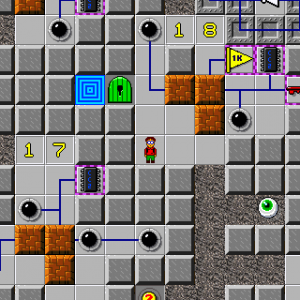Please create an account or Login! Have fun!
Sokoban level: Difference between revisions
Tylersontag (talk | contribs) m (Tylersontag moved page sokoban level to Sokoban level over redirect: revert) |
Indyindeed (talk | contribs) No edit summary |
||
| Line 1: | Line 1: | ||
[[Image: | [[Image:CC2 Level 100.png|300px|thumb|link=Crazy]] | ||
A '''Sokoban level''', alternately referred to as a ''Pocoman level'', is a term used to identify a level falling under | A '''Sokoban level''', alternately referred to as a ''Pocoman level'', is a term used to identify a level falling under a specific type of [[level theme]]: the movement of [[block]]s onto specific squares to either remove [[water]], [[bomb]]s, hold down [[trap]]s, or for some other objective. A ''Sokoban section'' means that part of the level holds this property. | ||
The shown level, [[ | The shown level, [[Crazy]], as well as its sequel, [[Crazy II]], are examples; Chip must move three blocks onto three [[black button]]s in each room to collect a [[computer chip]], a [[key]], and a [[bonus flag]]. | ||
Sokoban and Pocoman are two games that work the same way as these levels: the character must move objects onto squares, and then finishes the level when this is done. Therefore, the two terms are often used interchangeably. However, in particular, [[Chips on the Blocks]]'s first section is a direct copy of Pocoman's first level, which means it is usually called by that name. | Sokoban and Pocoman are two games that work the same way as these levels: the character must move objects onto squares, and then finishes the level when this is done. Therefore, the two terms are often used interchangeably. However, in particular, [[Chips on the Blocks]]'s first section is a direct copy of Pocoman's first level, which means it is usually called by that name. | ||
== Strategies for Sokoban levels == | == Strategies for Sokoban levels == | ||
An additional, less formal reference to a Sokoban level is a '' | An additional, less formal reference to a Sokoban level is a ''block pushing level'', so principles of block pushing are frequently used. In Crazy and Crazy II, all of the Sokoban sections must be solved quickly to obtain all of the bonus flags; to solve these levels faster, certain rules of Sokoban levels must be applied. The rules of [[Rule of double bridges|double bridges]], [[Rule of turning bridges|turning bridges]], and the [[Block Donut Rule]] and [[Block Retrace Rule]] come in handy as techniques for many Sokoban levels. | ||
[[Category:Terminology]] | [[Category:Terminology]] | ||
[[Category:Level themes]] | [[Category:Level themes]] | ||
Revision as of 11:05, 27 May 2019
A Sokoban level, alternately referred to as a Pocoman level, is a term used to identify a level falling under a specific type of level theme: the movement of blocks onto specific squares to either remove water, bombs, hold down traps, or for some other objective. A Sokoban section means that part of the level holds this property.
The shown level, Crazy, as well as its sequel, Crazy II, are examples; Chip must move three blocks onto three black buttons in each room to collect a computer chip, a key, and a bonus flag.
Sokoban and Pocoman are two games that work the same way as these levels: the character must move objects onto squares, and then finishes the level when this is done. Therefore, the two terms are often used interchangeably. However, in particular, Chips on the Blocks's first section is a direct copy of Pocoman's first level, which means it is usually called by that name.
Strategies for Sokoban levels
An additional, less formal reference to a Sokoban level is a block pushing level, so principles of block pushing are frequently used. In Crazy and Crazy II, all of the Sokoban sections must be solved quickly to obtain all of the bonus flags; to solve these levels faster, certain rules of Sokoban levels must be applied. The rules of double bridges, turning bridges, and the Block Donut Rule and Block Retrace Rule come in handy as techniques for many Sokoban levels.
